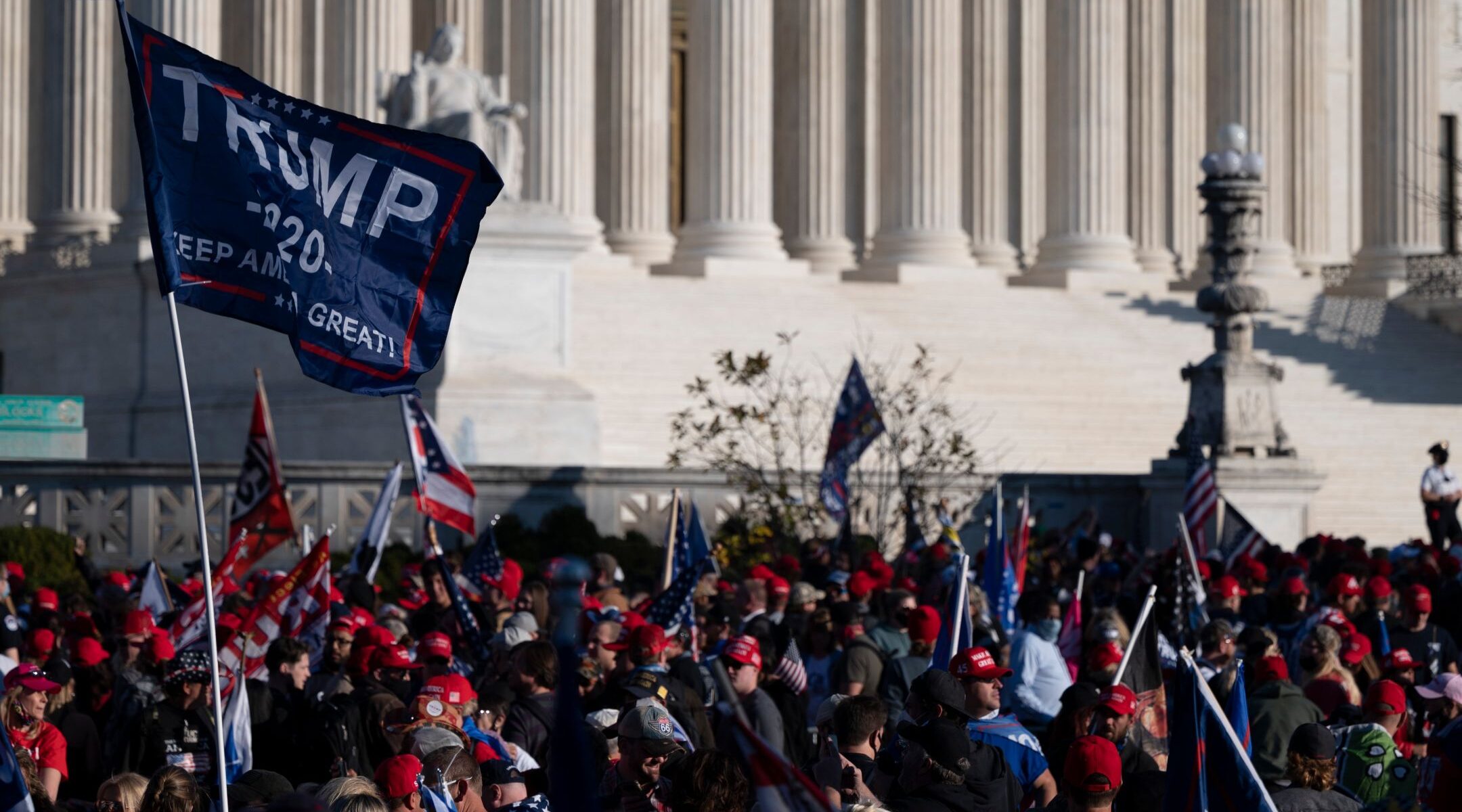(JTA) — It’s a Jewish ritual: Every four years after a presidential election, the question arises about how American Jews voted.
“Check the Jewish exit polls” is the rallying cry.
Those days may be over.
Blame apples and oranges and other assorted fruit: There is no longer a single exit poll to compare and contrast. That’s left the field open to partisan Jewish groups to post polls claiming movement in the direction they favor.
For instance, a poll commissioned by the Republican Jewish Coalition found that 30.5% of Jewish voters voted for GOP incumbent Donald Trump nationally compared to 60.6% for Democratic challenger Joe Biden.
“It’s not just the embassy that moved. Jewish voters are moving, too,” Ari Fleischer, George W. Bush’s former press secretary, said on an RJC conference call Nov. 4, the day after the election.
Meanwhile, a poll commissioned by the liberal group J Street found that 77% of Jewish Americans voted for Biden and only 21% for Trump.
“Trump pushed the Jewish vote further to the Democrats,” the group’s pollster wrote in a memo summarizing the results.
The two polls align on the big picture that the vast majority of Jewish voters supported the Democrat, as has long been the case in national elections. But is either group correct about the change they say happened over the past four years?
We may never know, in part because the major media consortium that traditionally cooperates in exit polls — the National Election Pool, which includes The New York Times, The Washington Post and CNN, among other outlets — did not post Jewish results this year.
In 2016, the National Election Pool found that 71% of Jewish voters chose Hillary Clinton and 24% opted for Trump. But there were no Jewish results posted this year, The Washington Post said, because there were “not enough respondents to break down details.”
The Associated Press, which once belonged to the consortium, left in 2018 and set up Votecast, which this year did include a Jewish breakdown. It found that 30% of Jewish Americans were voting for Trump and 68% for Biden. That analysis included about 3,300 Jewish voters (3% of the total 110,000 people surveyed).
Votecast includes major shifts in methodology from the National Election Pool exit polling system, including online panels and, in some cases, compensation for participating — departures substantive enough to make it impossible to compare with past National Election Pool polling.
Into the breach stepped the exit polls commissioned by the partisan RJC and J Street, which each revealed results that were favorable to the party that the commissioning groups side with.
Jim Gerstein, the GBAO Strategies founder who ran the J Street poll, said Friday that the AP analysis was not a reliable reader of Jewish attitudes because it did not seek to weight the Jewish subset.
“I would like to emphasize that the AP Poll is a very sound and helpful poll. They certainly know what they are doing, particularly when looking at the full electorate,” Gerstein told the Jewish Democratic Council of America during a conference call that allowed reporters. “But unlike our poll, that poll is not a Jewish poll. They cannot have the full body of demographic questions that are necessary to acquire a representative Jewish sample.”
The Jewish Telegraphic Agency was unable to view the breakdown of Jewish voters in the Votecast poll without paying a steep licensing fee.
The RJC and J Street polls did release detailed information about the voters they surveyed, but both had a relatively small number of respondents. And other aspects of their survey design meant that they cannot be cleanly compared.
Both the RJC and J Street polls were completed during the same time period, had similar margins of error (3.5-4%) and included hundreds of Jewish voters — 600 for the RJC and 800 for J Street. But the RJC survey included more Orthodox Jews, who tend to vote Republican, and fewer Reform and unaffiliated Jews, who tend to be solidly Democratic, than the J Street poll. That could explain why the RJC poll yielded a result that suggests more Trump voters.
The RJC’s executive director, Matt Brooks, emphasized during the post-election conference call that his group’s results mirrored those in other polls, such as one taken in September and the AP analysis released last week.
“Polling, like any other science, depends on replicating results to provide proof,” the group’s communications director, Neil Boylan Strauss, told JTA. “In this case, our results have been replicated.”
Gerstein said on the call Friday that the J Street model was based on religious affiliation surveys by the Pew Research Center, the leading company analyzing religious affiliation. The Pew analysis is from 2013, however, and the proportion of Orthodox Jews since then is likely to have increased.
“Our poll is specifically designed to get a representative sample of Jewish voters, and we follow the language and demographic information that’s used by the Pew Research Center, which has set the gold standard for researching American Jews,” he said.
Both surveys asked a range of questions, but again in ways that made them difficult to compare. For instance, asked to rank issues, both J Street and the RJC included handling of the pandemic as an option. It ranked first among J Street respondents, but RJC included a category that J Street did not, “character of the candidates,” that ranked higher among respondents.
In both surveys, foreign policy and Israel were among the lowest-ranked issues.
Laura E. Adkins contributed reporting.
JTA has documented Jewish history in real-time for over a century. Keep our journalism strong by joining us in supporting independent, award-winning reporting.






